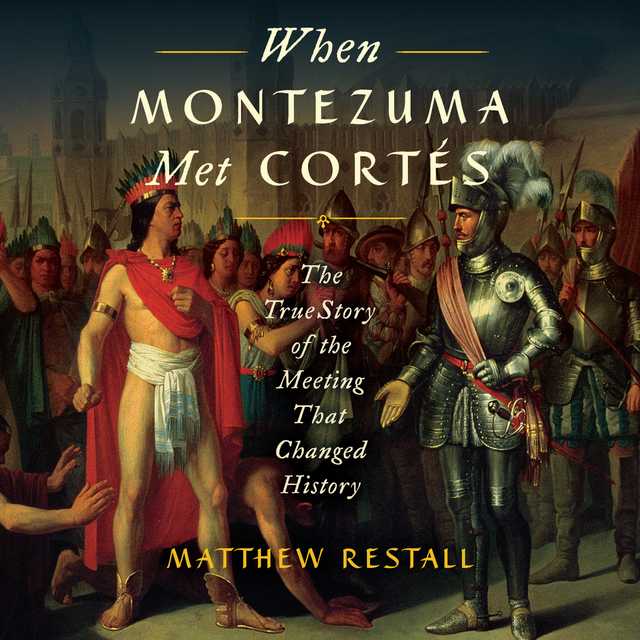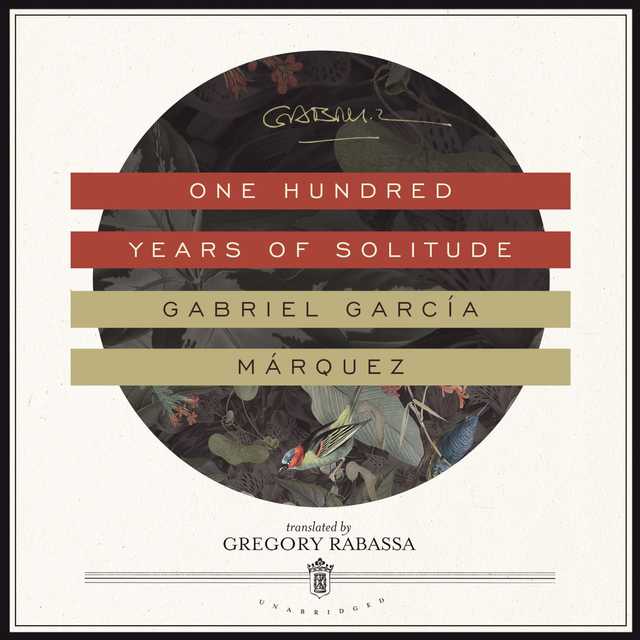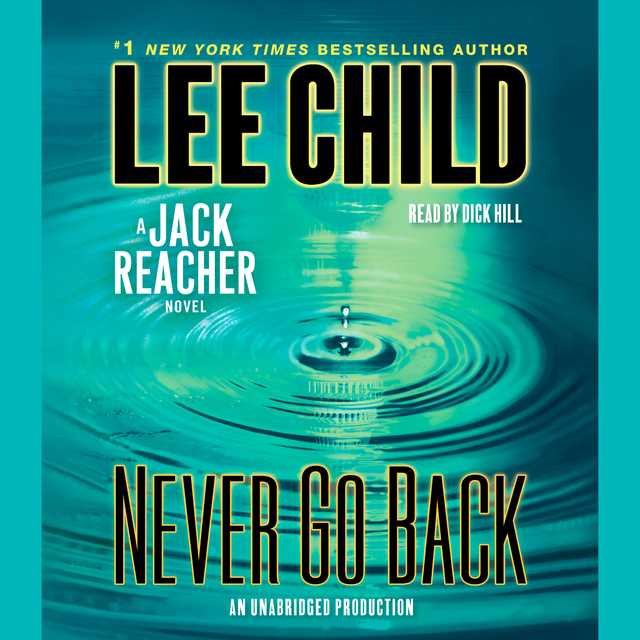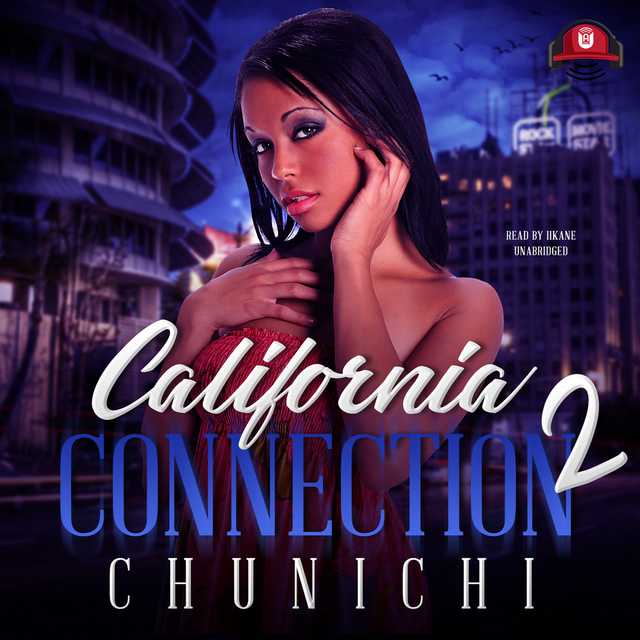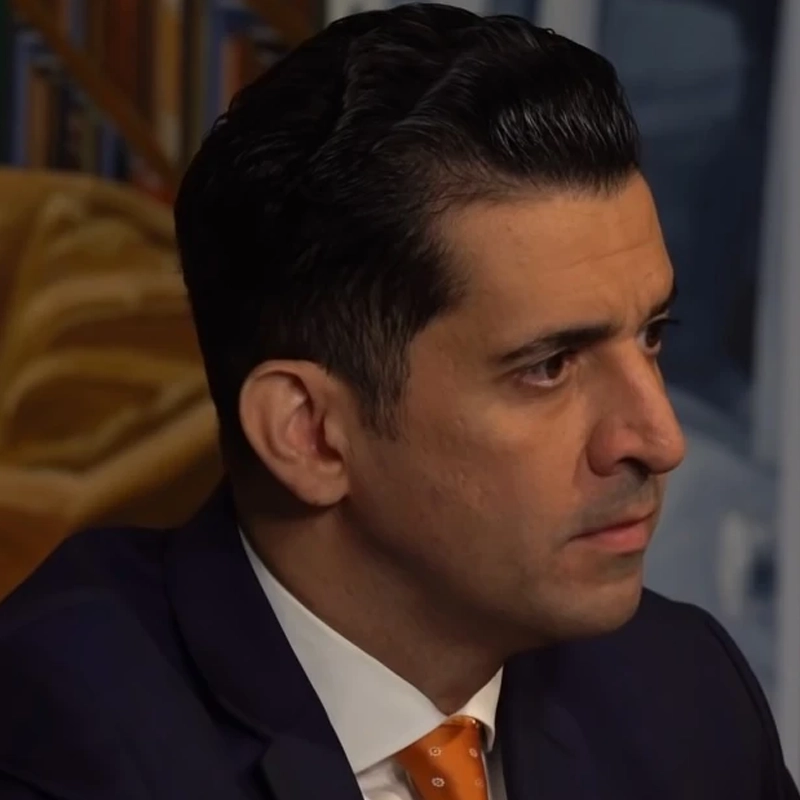When Montezuma Met Cortes Audiobook Summary
A dramatic rethinking of the encounter between Montezuma and Hernando Cortes that completely overturns what we know about the Spanish conquest of the Americas
On November 8, 1519, the Spanish conquistador Hernando Cortes first met Montezuma, the Aztec emperor, at the entrance to the capital city of Tenochtitlan. This introduction–the prelude to the Spanish seizure of Mexico City and to European colonization of the mainland of the Americas–has long been the symbol of Cortes’s bold and brilliant military genius. Montezuma, on the other hand, is remembered as a coward who gave away a vast empire and touched off a wave of colonial invasions across the hemisphere.
But is this really what happened? In a departure from traditional tellings, When Montezuma Met Cortes uses “the Meeting”–as Restall dubs their first encounter–as the entry point into a comprehensive reevaluation of both Cortes and Montezuma. Drawing on rare primary sources and overlooked accounts by conquistadors and Aztecs alike, Restall explores Cortes’s and Montezuma’s posthumous reputations, their achievements and failures, and the worlds in which they lived–leading, step by step, to a dramatic inversion of the old story. As Restall takes us through this sweeping, revisionist account of a pivotal moment in modern civilization, he calls into question our view of the history of the Americas, and, indeed, of history itself.
Other Top Audiobooks
When Montezuma Met Cortes Audiobook Narrator
Steven Crossley is the narrator of When Montezuma Met Cortes audiobook that was written by Matthew Restall
Matthew Restall is the Edwin Erle Sparks Professor of Latin American History and director of Latin American studies at Pennsylvania State University. He is president of the American Society for Ethnohistory, and has held fellowships from the Guggenheim Foundation, the Institute for Advanced Study at Princeton, the John Carter Brown Library, the Library of Congress, and the National Endowment for the Humanities. He has written twenty books and sixty articles and essays on the histories of the Mayas, of Africans in Spanish America, and of the Spanish Conquest. He lives in State College, Pennsylvania, with his wife and the youngest of his four daughters.
About the Author(s) of When Montezuma Met Cortes
Matthew Restall is the author of When Montezuma Met Cortes
More From the Same
- Author : Matthew Restall
- The Maya
- Seven Myths of the Spanish Conquest
- Publisher : HarperAudio
- Abraham
- American Gods [TV Tie-In]
- Dead Ringer
- House of Sand and Fog
- Prey
When Montezuma Met Cortes Full Details
| Narrator | Steven Crossley |
| Length | 16 hours 5 minutes |
| Author | Matthew Restall |
| Category | |
| Publisher | HarperAudio |
| Release date | January 30, 2018 |
| ISBN | 9780062797902 |
Subjects
The publisher of the When Montezuma Met Cortes is HarperAudio. includes the following subjects: The BISAC Subject Code is History, Latin America, Mexico
Additional info
The publisher of the When Montezuma Met Cortes is HarperAudio. The imprint is HarperAudio. It is supplied by HarperAudio. The ISBN-13 is 9780062797902.
Global Availability
This book is only available in the United States.
Goodreads Reviews
James
August 09, 2018
Next year will be the 500th anniversary of Cortes's entrance into Tenochtitlan, the capital of the Aztec peoples of Mesoamerica. Such a long span of time helps explain the story's blurring. Much of what we think we know of the Aztecs and the Spanish conquest of Mexico is wrong. Restall calls his history a revisionist one because he tries to correct the misperceptions and exaggerations which have grown from the various histories written about those events. He explains that those blurred lines are history.In effect his book explains how the Cortes story has hurdled history to become mythohistory. Restall doesn't tell the story chronologically until the end of the book. Nevertheless, all the essential elements are here as he spends time with the particular facts which make it up. So here are detailed discussions of Cortes's mission, the famous burning of the boats, who Marina, Cortes's Nahua translator/lover was, the politics of Mesoamerica and the politics of the Spanish, conquistador mentality, and much more. Most interesting and surprising is the description of what's perhaps the most famous event of the conquest, the moment on 8 Nov 1519 when Montezuma met Cortes on the causeway leading into the city situated on an island in what was then Lake Texcoco and how what the Spanish called a surrender was in fact a captivity. And how the 2-year war unfolded from the Aztec and Spanish misunderstanding of their respective cultures and intentions, resulting in, essentially, the destruction of both.Restall excavates many layers of history and legend to get to the bedrock he calls the truth. Much of his history is explaining how the events of the past are remembered and chronicled in ways reflecting the agendas of the many factions involved. His history is a sifting through the inventions and inadvertent distortions and inevitable blanks in the record to get at the bedrock of what really happened. Restall writes, "I have had to describe the myth in detail, to expose history as mythistory, in order to bust it." His meditation on history and his retelling of the conquest of the Aztecs by Cortes and company is convincing, fascinating reading.
Fila Trece
September 14, 2018
Interesantísimo libro que desmitifica los hechos alrededor de la conquista de México.Basado mucho en la lógica y en una profunda investigación, Restall trata de discernir cómo debieron suceder los eventos que llevaron a la conquista de México, haciendo un énfasis especial en desmentir la pobre visión que se tiene de Moctezuma y la desproporcionadas reacciones (algunas muy positivas y otras muy negativas) sobre la figura de Cortés.Básicamente llega a la conclusión de que Moctezuma fue un gran tlatoani, que nunca se rindió ni temió a los españoles, y que por el contrario hizo todo lo posible por someterlos (coleccionarlos es su teoría), mientras que Cortés jamás tuvo control de nada, y fue más bien un militar común cuyas hazañas se debieron a otras personas y factores más que a méritos propios. La conquista no fue una campaña ordenada y estructurada, sino dos años de guerra y genocidio entre las poblaciones indígenas promovida por los españoles.El gran problema del libro es que no es una lectura fácil. Restall incluye demasiadas referencias y se pone demasiado académico por momentos, además de que no hay una narrativa bien establecida y saltamos de un tema a otro sin mucho orden. Intenta hacer un libro para todo público, pero se le olvidan los detalles que hacen que estos libros funcionen. Así que uno arrastra bastante los pies para llegar a las conclusiones, y tiene que unir las piezas de información regada por todos lados. Me tardé bastante en terminarlo.Aún así, se trata de información y conclusiones muy interesantes. A mí me gusta mucho la historia de las culturas prehispánicas y la de la conquista, y este libro me ha abierto los ojos a muchos hechos y contradicciones de los que estaba consciente, pero que nunca había profundizado.Lectura obligada para quienes gustan de esta etapa de la historia de México.
Michael
May 31, 2018
Rethinking “the conquest of Mexico” from the native point of view—the “Spanish-Aztec War.” It’s fascinating but very tough because there is so little to go on from the Aztec side since they had no formal written language and records. And the Spanish preserved few if any memories of how things really were before their arrival, wiping it all clean. No religious texts, no history books, no philosophy treatises, no gossip and tales. No nothing. The truth will never be known. All irretrievably lost. Cultural genocide to go along with all the thorough rest. A great shame and pity.
Jimmy
January 13, 2020
What if everything you heard about the Conquistor Hernando Cortés and the Aztec emperor Montezuma was incorrect? This book is a work of superb historical scholarship that goes against the grain of mainstream narrative that often glorify Cortés. In peeling back the myth we get closer to the truth of what actually happened in history between Cortés and the Aztecs. This book makes a strong case of how people even today have not look at him and his claims critically enough even by those who teach history. For myself a fascinating part of the book is the looks at who the Aztec emperor name Montezuma was. I didn’t know much about him before the book. I thought it was interesting how the author documents Montezuma was a big collector and even had a zoo collection that show what he prized and control. From this observation author Robert Greenberger noted the proximity of where Montezuma placed the Spanish Conquistors near the zoo and argued that when Montezuma fed and provided shelter to these Europeans it wasn’t a concession of defeat but a way for Montezuma to say he has added them to his other collection of creatures, people and things and that he had them in order to further study them. The book talks about the myth of Aztec surrender in the beginning of Cortés trip. Even with this story we see that there’s a clash of two cultures when Cortés met Montezuma. I appreciated how the book document the way people communicated in Aztec court was formal and a characteristic of formal Aztec language was humility. Even as powerful a king as Montezuma cannot risk not being humble in which strengths are downplayed and even stated in terms of its opposite as weakness. This may have contributed to Cortés’ misunderstanding of Montezuma as weak or giving in to the Spaniards when it was otherwise.Of course there is more documentary sources on Cortés than Montezuma and here the book gives us a less than flattering look of Cortés but the tone one gets from the author is not that this is a hit piece but the author wanting to peel back the layers of myths from the man. So much of the mainstream narrative paints Cortz as a great controller of his destiny but historical analysis reveal otherwise. Even in the beginning Cortés was not in charge as much as he thinks but he was appointed leader as a result of rivalries between various leaders and factions so the less remarkable Cortés was appointed. The book also made a point that Cortés was played by the indigenous peoples themselves against their traditional foes whether they be the Aztecs who used the Spaniards to fight their enemies or vice versa. Furthermore contrary to the popular idea that Cortés’ small forces conquered numerically superior native Americans with their technology and tactics the book goes over facts of how there were alliances with bigger native forces that brought about the huge bloodshed rather than it being inflicted by the Spaniards alone. Sixty to seventy percent of casualties was due to arrow wounds which indicates Cortés was not the superior military genius and tactician that the myths has made him out to be. Quite convincingly for me is the argument made by the author towards the end of the book that Cortés was not as exceptional and important as he thinks of himself. In his later years Cortés wanted to be made governor but was never appointed as one but instead as a mere captain and never got the lucrative financial fall out he was hoping to achieve with his adventure and exploration. Again the book is not a “hit piece” but was quite balanced and made the point that Cortés can bring brag about surviving when most people landing in North America did not at that time. The book does discuss the darker side of the Conquistors. Readers must be advised that there’s the uncomfortable subject of rape and slavery. The author is not making conjectures here but looks at the archive record with details of conquests and booty acquired from fighting including records about “pretty women.” A lot of justification for imperialism and colonialism of the Aztecs and other people in America during that time is the fact that the people were pagans and participants of human sacrifice. The author makes it clear one don’t have to pick either/or and between the choice of military conquests and supporting the status quo of human sacrifice one doesn’t have to support either. That’s a good point that the author spelled out explicitly towards the end of the book in discussing about the legacy of Montezuma meeting Cortés.Fascinating book and well researched historical work. I recommend it.
Lukas
October 26, 2022
What I would give to step into a time machine and be transported to Mexico in the year 1519 and see Tenochitlan, the island city of the Mexica, with its canoes, causeways and, as I learned from this book, giant imperial botanical and zoo complex.Restall's thesis is that Montezuma never surrendered to Cortes and his conquistadors but actually lured him into Tenochitlan to observe and study them before eventually killing and ritually sacrificing them when they would get restless. I have no quarrel with this claim, except that I do not share Restall's implicit praise for this strategy. Bringing 450 violent men into the very heart of your court, close to your family members and to the epicenter of power does not strike me as a clever move, despite what Restall implies. Montezuma to some degree accelerated his own downfall. Restall does a good job at sorting the fact from the fiction to debunk all the myths surrounding the Aztecs, the Spanish conquest and especially the figure of Hernan Cortes. The chapter on ritual sacrifice (the supposed bread and butter of Aztec daily life) is quite entertaining, especially reading Restall criticize the ridiculous numbers thrown around by earlier historians. The book is rather historiography-heavy, which can get a bit tiresome for those who are more interested in what actually happened. Of course Restall would respond that the historiography is part of the history, but this sounds like a partly rhetorical quip to me. I also like Restall's way of distinguishing between genocide in effect, which I agree the Spanish conquest falls under, and genocide in intent. The scale and character of the violence that erupted after the Spanish arrived were mind-blowing. It is very interestiglng how Restall describes the way that slavery of Indians functioned and how it was lamely justified by the Spaniards ("Montezuma surrendered, then many of the Indians 'rebelled', so they are fair game"). Restall also gives a revealing analysis of local Nahua politics, with two rivaling triple alliances, headed by the Mexica of Tenochitlan and the Tlaxcalteca respectively, which were completely destabilized by the entry of the Caxtilteca (or Castilians) and their utterly foreign 'total war' methods, fighting for conquest and targeting the civilian population whilst doing so. Although Restall argues that the Spaniards depended heavily on the help of these local lords to defeat the Mexica (Aztecs), one thing that I would have liked to learn more about is why, after the fall of Tenochitlan, the Spanish indigenous allies did not see the writing on the wall and attempt to roll back the Spanish presence. Perhaps the reason is that the Spanish allies had more to gain, also relative to other tribes, in the short term from continued cooperation. In a sense, then, they fell victim to a kind of prisoner's dilemma. Had there been a stronger shared identity among the Nahua kingdoms ('altepetl') or even among all the Mesoamerican tribes, they would have been able to control the pace of Spanish conquest better.
Esteban
February 12, 2023
Es un trabajo de investigación exhaustivo, basta ver la bibliografía y de todas las fuentes a las que recurrió Matthew Restall, probablemente miles de horas; Vale la pena la reconstrucción de la invasión de los españoles a tierras mexicanas, la invensión de las mitohistorias para poder justificar su invasión, su imposición religiosa, sus actos de piratería y la destrucción de una gran cultura desvirtuandola con exageraciones de los hechos, los sacrificios y canibalismo a tal punto de compararlo conel mismísimo infierno.La mentira orignal creada por los conquistadores (piratas) y los padrecitos franciscanos lo hicieron de manera reiterativa a través de los siglos hasta que todo el mundo lo creyó.Las prácticas europeas ironizan la matanza y genocidio de los pueblos Prehispánicos con los millones y millones de muertos en las grandes guerras por decisiones económicas y políticas y esto no es mas que irónico, hipócrita y etnocentrico.Es por esto y más que se ha convertido en el mejor libro de este genero que he leído (ya llevo varios) en mi favorito; muy recomendable.
Valerie
September 11, 2019
I was lured in by the step pyramid of these at the Denver Airport. Paper books being relegated to the few privileged people who can afford to travel by air.I love first contact sci fi, and this history book caused me to think about this fabled meeting in that context. Two different cultures, with different value systems, a double translator incapable of communicating all of the social nuance, unintended consequences, and a careful retelling of events to achieve the desired point of view on the home planet...I mean Spain.The author is very good about establishing fact and primary sources from secondary sources and interpetation through the lens of time and current mores, which I appreciated.I was a little disturbed at how little Mexican history I have at my command, so some of the primary sources will probably make their way to my reading list.
Ian
June 06, 2022
The author of this book offers a very undiluted, unbiased perspective of a time where so little was written down. Makes you wish you had a time machine to see exactly what happened back then...though I get the feeling I would crash land in 1512 and immediately get my ass disemboweled.
Amber
February 09, 2021
I think this is an important one. I recommend reading it before reading "Fifth Sun" by Camilla Townsend. Where "Fifth Sun" is detailed about the the Nahua and Indigenous historical perspective, Restall takes a broad and comprehensive perspective. I wish I had read this book before Townsend's, I feel it would have helped me understand the environment and circumstances more clearly.Restall has cracked my heart open, but this time it's a healing. A healing of history and memory. His research is extensive and well documented leaving a fourth of the book to notes, references and bibliography. Restall expertly draws not only on first person historical, and legal documents, but he also evaluates the historical record through its art, performance, and culture, giving us a grounded perspective in ideas, and the social psyche. I am Mexican, born and raised on stolen and raped land and I have always been mystified and angry about the "conquest". Restall has given me an understanding my whole self and my ancestors can rest with.Restall reviews the evidence and repositions conquest as war, the Spanish-Aztec war. As well, he reveals the genocidal and racist motives that undergirded that war and devastated one of the most civil and advanced societies in the Americas. This book is literally a work of decolonial action.
Peter
April 27, 2018
“When Montezuma Met Cortés: the true story of the meeting that changed history,” by Matthew Restall (HarperCollins, 2018). Long story short: Cortés was not the brilliant, courageous, visionary, world-striding conqueror he has long been presented as. Montezuma was not a blithering, cowardly, effeminate loser. The reverse: Cortés was a mediocre, not very enterprising, lower level conquistador with talents for self-promotion and survival. Montezuma was a well-established, confident ruler with a history of military success who lured the Spanish deep into his own kingdom with the intention of adding them to his collection of zoological specimens (the Aztecs had a zoo in Tenochtitlan). In addition, the Spanish incursion was inserted into a long-standing conflict between the Aztec alliance of three kingdoms and the Tlaxcalteca Triple Alliance. The Spanish were being used by the locals. The famous meeting and embrace between Montezuma and Cortés was not a sign that the Aztecs were surrendering and accepting the Spanish as their overlords. In truth, according to Mesoamerican custom, Montezuma was showing his dominance over the newcomers. Unfortunately for the Aztecs (and the rest of Mesoamerica), the Spanish were much more dangerous animals than they knew, escaped from their luxurious cages, and destroyed much of Mesoamerican society. On the surface, the book has an odd structure: Restall spends much of the time describing how Cortés has been seen in western art, literature and culture. He cites plays, poems, novels, sculpture, painting from the 16th century up to today. Gradually, as the book continues, Restall digs more deeply into other Spanish accounts, and surviving accounts written by the locals. He does a lot of extrapolation and informed speculation. Among other things, he reads Spanish, French, German, Italian, Latin---and NAHUATL, the language of the actual inhabitant, who did not call themselves Aztecs. They called themselves Nahua, and the inhabitants of Tenochtitlan and its surrounding kingdom were Mexica. So Restall is quoting what the Aztec/Nahua themselves wrote. Not to mention that after the “conquest” (which was a horribly bloody affair close to genocide, though neither the term nor the concept existed at the time) there was so much intermarriage that most of the Mexica ruling families continued to hold power. They just added Spanish names to their own. Remarkable and fascinating. There are so many semi-digressions: what was the actual population of the city---about 60,000, nowhere near a million; the Spanish were extremely brutal, murdering each other as much as the natives, and raping women and girls by the tens of thousands; how was the war different from other wars ---it wasn’t; who was Malintzin? There was no legend of Quetzalcoatl and a returning god; Cortes did not burn his ships; etc etc etc. Restall destroys myths and legends I didn’t know existed. He calls the event the Spanish-Aztec War, not the Conquest. The Spanish did not win so much as their constant, uncontrollable presence and destruction of many of the leading aristocracy so destabilized the Nahua society that it collapsed. One riddle Restall cannot solve: how did Montezuma die? Was he killed by the Nahua as a traitor? Was he murdered by the Spanish? On a side note: the Nahua names are so complicated I gave up trying to keep them separate, let alone try to pronounce them: Tetlahuehuetzquititl; Nezahualcoyotl; Izhuetzcatocatl; Ixtlilxohitl. Amazing. https://www.matthewrestall.com/
Cris
February 22, 2021
A must-read for any Aztec aficionados or fans of Precolombian, contact, and Mexican history. Honestly, any introspective, history-oriented Mexican mestizo should be forced to read this book. Not only is Restall's spicy dispelling of Cortesian legend immensely gratifying for those who still can't get over the fall of Tenochtitlan, but hidden within Restall's long-winded prose are gems which shed light on the paradoxical nature of being mestizo- of frustratingly having both the blood of conquistadors and indios flowing through your veins, not knowing whether that lightskinned-ness was injected consensually or not, loving your Spanish side for its beautiful language and culture in one moment, cursing it for its disgusting colonial abuses the next. Perhaps that's why, as Restall elaborates, we Mexicans love to hate Cortes- as he will forever occupy a primal corner of the Mexican psyche, hating him is tantamount to hating ourselves. And trust me, a lot of Mexicans subconsciously do so. Fair skin is much sought-after in Mexican society (much like in India), and a lot old money from those colonial days still lives on in the bank accounts of some blue-eyed, blonde haired elites. Not conquistadors anymore, per se, but there's something amiss about Mexico's racial dynamics which ultimately ties back to that fateful clash between steel and obsidian in 1521.And besides all that identity stuff, Restall's novel is jam-packed with so many obscure historical details about the Spanish-Aztec war which will likely blow the minds of any non-scholarly Aztec lovers. The passion, dedication, and depth of Restall's knowledge just bleeds through the pages.But if you don't like thick, academic (and sometimes eyeroll-inducingly conceited) language, then beware. Furthermore, if you're not a huge fan of the book's subject matter, then reading this can become sheer drudgery. Even for me, Restall has a way of droning about which gets old fast. Thankfully, though, his book redeems itself in many other eye-opening, if not soulful, ways.
Kim Tim
August 10, 2022
The book is sorta long, and complicated at times, but it is pretty thorough and it is worth it if you want to read more about the spanish-aztec war, or are just generally interested in history. And of course, we don't know everything that went down. That doesn't dismiss that much of what is written here is based on historical proof. Interpretations too, but there is enough evidence to back up what the author is saying. It paints a different picture of the war and Montezuma and Cortes. (Although mainly towards the end do we see Cortes's life and how he wasn't a "monster" but what was considered a "normal spaniard". Although full details and proof, for the lack of a better word, i feel like we do see how the author nonetheless is a bit biased towards how Cortes/spaniards are quite the villains here, and only in the end do we read how they are not barbaric monsters as shown throughout the whole book, but as i said "normal spaniards" and how they apparently had their reasons.) What i wish was more delved into is the "accident"/start of the war (officially), when Pedro de Alvarado attacked the Aztecs. Because towards the end of the book it is made known (for the first time) that the author isn't trying to demonize the spaniards but understand them/see their side. But then we go back to how spaniards/Alvarado was a monster. So i would have liked to read why (in the author's opinion) did he attack them then. Did they really show their cannibalism and if yes, why is he portrayed as a monster instead of at least a little understood? (In the beginning all i remember about "reasons" is how he, but also us, "don't understand aztec culture" that for them it was normal etc) And if he didn't witness that then what happened? An "explanation" other than previoisly mentioned or "they panicked" that is. This scene was quite interesting to me from the start so i would have liked a bit more info on that part.
Ryan
March 29, 2020
** spoiler alert ** Matthew Restall’s book, When Montezuma Met Cortez, ends with a chapter titled ‘The Halls of Montezuma’ symbolizing the hall of history in which we can peer back in time to see what actually occurred. Of course, the farther the hall is, the blurrier it gets to our modern eyes. As Restall discusses throughout the book, this hall has been muddied by the eventual victor of the Spanish-Aztec War—the Spanish. With their formidable allies consisting of horses, dogs, gunpowder, armor, scabbards, and of course disease, they utilized their powerful influence over Western history to shape this history. I like to think a good analogy to what Restall believes happened at the Meeting is Montezuma’s zoo. Montezuma had a zoo filled with all sorts of animals. What he does to Cortez and the conquistadors is prey on and lure them into Tenochtitlán by sending peace and gifts. How do you lure in a wild, foreign beast? You tease and tempt it with something it wants. Once they were in the city, he placed them up right next to his zoo, seemingly capturing the conquistadors just like the animals cooped up there constantly being watched and tested on. Of course, from there, things don’t go Montezuma’s way and the conquistadors eventually take over. However, Montezuma’s diplomacy, which was initially thought to be cowardly, seems to be intelligent and successful from this new insight.Restall tussles with the material like this from various sources throughout the entire hall of history. He finds much contradictory information throughout and investigates reasons why this information got tangled into this story and theorizes ways it became part of the hall of history. He wants us to rethink what has been entwined into the common historical knowledge. It makes one question any bit of knowledge that is considered factual.
Socraticgadfly
April 05, 2018
This is "revisionist history" at its best. The book is dense at times and does jump around somewhat.That said, if one looks at Restall's author page, he's definitely got the background and the chops to know what he's talking about. His general reframing ideas are sound.For one reviewer who doesn't like Restall's calling the Aztec sacrifices 'executions,' how do you know that, too, isn't part of Spanish reframing?For the unfamiliar, Restall's thesis is that Montezuma did NOT "surrender." He instead invited the Spaniards to his city while basically placing them on house probation. Restall also says the Triple Alliance and other pro- and anti-"Aztec" relations in the Valley of Mexico were more complex than the Spanish presented. Finally, he says that Montezuma's death and the last battles didn't go down exactly the way traditionally presented.Per some academics, the idea that these are "myths" is really only for norteamericanos who don't know better.
Most Popular Audiobooks
Frequently asked questions
Listening to audiobooks not only easy, it is also very convenient. You can listen to audiobooks on almost every device. From your laptop to your smart phone or even a smart speaker like Apple HomePod or even Alexa. Here’s how you can get started listening to audiobooks.
- 1. Download your favorite audiobook app such as Speechify.
- 2. Sign up for an account.
- 3. Browse the library for the best audiobooks and select the first one for free
- 4. Download the audiobook file to your device
- 5. Open the Speechify audiobook app and select the audiobook you want to listen to.
- 6. Adjust the playback speed and other settings to your preference.
- 7. Press play and enjoy!
While you can listen to the bestsellers on almost any device, and preferences may vary, generally smart phones are offer the most convenience factor. You could be working out, grocery shopping, or even watching your dog in the dog park on a Saturday morning.
However, most audiobook apps work across multiple devices so you can pick up that riveting new Stephen King book you started at the dog park, back on your laptop when you get back home.
Speechify is one of the best apps for audiobooks. The pricing structure is the most competitive in the market and the app is easy to use. It features the best sellers and award winning authors. Listen to your favorite books or discover new ones and listen to real voice actors read to you. Getting started is easy, the first book is free.
Research showcasing the brain health benefits of reading on a regular basis is wide-ranging and undeniable. However, research comparing the benefits of reading vs listening is much more sparse. According to professor of psychology and author Dr. Kristen Willeumier, though, there is good reason to believe that the reading experience provided by audiobooks offers many of the same brain benefits as reading a physical book.
Audiobooks are recordings of books that are read aloud by a professional voice actor. The recordings are typically available for purchase and download in digital formats such as MP3, WMA, or AAC. They can also be streamed from online services like Speechify, Audible, AppleBooks, or Spotify.
You simply download the app onto your smart phone, create your account, and in Speechify, you can choose your first book, from our vast library of best-sellers and classics, to read for free.
Audiobooks, like real books can add up over time. Here’s where you can listen to audiobooks for free. Speechify let’s you read your first best seller for free. Apart from that, we have a vast selection of free audiobooks that you can enjoy. Get the same rich experience no matter if the book was free or not.
It depends. Yes, there are free audiobooks and paid audiobooks. Speechify offers a blend of both!
It varies. The easiest way depends on a few things. The app and service you use, which device, and platform. Speechify is the easiest way to listen to audiobooks. Downloading the app is quick. It is not a large app and does not eat up space on your iPhone or Android device.
Listening to audiobooks on your smart phone, with Speechify, is the easiest way to listen to audiobooks.

